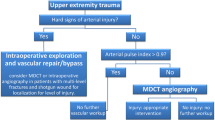Abstract
Unrecognized arterial injuries in patients with blunt peripheral trauma can cause significant morbidity. Rapid diagnosis and localization of arterial injury is required for choosing the optimal surgical strategy in patients with extremity trauma. Multidetector computed tomography (MDCT) arteriography provides an accurate, rapid, and noninvasive means for diagnosis of arterial injuries. We discuss and depict the spectrum of findings on MDCT arteriography in acute blunt peripheral trauma.







Similar content being viewed by others
References
Caps MT (2000) The Epidemiology of Vascular Trauma. In: Rutherford RB (ed) ‘Vascular Surgery’. Saunders, Philadelphia, PA, pp 857–862
Abou-Sayed H, Berger DL (2002) Blunt lower-extremity trauma and popliteal artery injuries Arch Surg 137:585–589
Treiman GS, Yellin AE, Weaver FA, Wang S, Ghalambor N, Barlow W et al (1992) Examination of the patient with a knee dislocation: The case for selective arteriography Arch Surg 127:1056–1062
Moneim MS, Garst JR (1995) Vascular injuies associated with elbow fractures and dislocations Int Angiol 14:307–312
Ketz MD, Hanks SE (2006) In: Baum S, Pentecost MJ (eds) Angiography and transcatheter treatment of extremity trauma‘Abrams' angiography interventional radiology’. Lippincott Williams Wilkins, Philadelphia, PA, pp 991–1003
Frykberg ER (1995) Advances in the diagnosis and treatment of extremity vascular trauma. Surg Clin North Am 75:207–223
Frykberg ER, Crump JM, Vines FS, McLellan GL, Dennis JW, Brunner RG et al (1989) A reassessment of the role of arteriography in penetrating proximity extremity trauma: a prospective study. J Trauma 29:1041–1052
Frykberg ER, Dennis JW, Bishop K, Laneve L, Alexander RH (1991) The reliability of physical examination in the evaluation of penetrating extremity trauma for vascular injury: results at one year. J Trauma 31:502–511
AbuRahma AF, Robinson PA, Boland JP, Umstot RK, Clubb EA, Grandia RA et al (1993) Complications of arteriography in a recent series of 707 cases: factors affecting outcome. Ann Vasc Surg 7:122–129
Weaver FA, Yellin AE, Bauer M, Oberg J, Ghalambor N, Emmanuel RP et al (1990) Is arterial proximity a valid indication for arteriography in penetrating extremity trauma? A prospective analysis. Arch Surg 125:1256–1260
Nunez D, Rivas L, McKenney K, LeBleng S, Zuluaga A (1998) Helical CT of traumatic arterial injuries. AJR Am J Roentgenol 170:1621–1626
Schwartz MR, Weaver FA, Bauer M, Siegel A, Yellin AE (1993) Refining the indications for arteriography in penetrating extremity trauma: a prospective analysis. J Vasc Surg 17:116–124
Lynch K, Johansen K (1991) Can Doppler pressure measurements replace “exclusion” arteriography in the diagnosis of occult extremity arterial trauma? Ann Surg 214:737–741
Johansen K, Lynch K, Paun M, Copass M (1991) Non-invasive vascular tests reliably exclude occult arterial trauma in injured extremities. J Trauma 31:515–522
Rieger M, Mallouhi A, Tauscher T, Lutz M, Jaschke WR (2006) Traumatic arterial injuries of the extremities: initial evaluation with MDCT angiography. AJR Am J Roentgenol 186:656–664
Hiatt MD, Fleischmann D, Hellinger JC, Rubin GD (2005) Angiographic imaging of the lower extremities with multidetector CT. Radiol Clin North Am 43:1119–1127
Busquets AR, Acosta JA, Colon E, Alejandro KV, Rodriguez P (2004) Helical computed tomographic angiography for the diagnosis of traumatic arterial injuries of the extremities. J Trauma 56:625–628
Ofer A, Nitecki SS, Linn S, Epelman M, Fischer D, Karram T et al (2003) Multidetector CT angiography of peripheral vascular disease: a prospective comparison with intraarterial digital subtraction angiography. AJR Am J Roentgenol 180:719–724
Rubin GD, Schmidt AJ, Logan LJ, Sofilos MC (2001) Multi-detector row CT angiography of lower extremity arterial inflow and runoff: initial experience. Radiology 221:146–158
Inaba K, Potzman J, Munera F, McKenney M, Munoz R, Rivas L et al (2006) Multi-slice CT angiography for arterial evaluation of the injured lower extremity. J Trauma 60:502–507
Dennis JW, Frykberg ER, Veldenz HC, Huffman S, Menawat SS (1998) Validation of nonoperative management of occult vascular injuries and accuracy of physical examination alone in penetrating extremity trauma: 5- to 10-year follow-up. J Trauma 44:243–253
Yetkin U, Gurbuz A (2003) Post-traumatic pseudoaneurysm of the brachial artery and its surgical treatment. Texas Heart Inst J 30:293–297
Hirsch AT, Haskal ZJ, Hertzer NR, Bakal CW, Creager MA, Halperin JL et al (2006) ACC/AHA 2005 practice guidelines for the management of patients with peripheral arterial disease (lower extremity, renal, mesenteric, and abdominal aortic): executive summary. Circulation 113:1474–1547
Soto JA, Munera F, Morales C, Lopera JE, Holguin D, Guarin O et al (2001) Focal arterial injuries of the proximal extremities: helical CT arteriography as the initial method of diagnosis. Radiology 218:188–194
Author information
Authors and Affiliations
Corresponding author
Rights and permissions
About this article
Cite this article
Kalra, N., Khandelwal, N., Gupta, P. et al. MDCT arteriographic spectrum in acute blunt peripheral trauma—a pictorial review. Emerg Radiol 15, 91–97 (2008). https://doi.org/10.1007/s10140-007-0687-9
Received:
Accepted:
Published:
Issue Date:
DOI: https://doi.org/10.1007/s10140-007-0687-9




